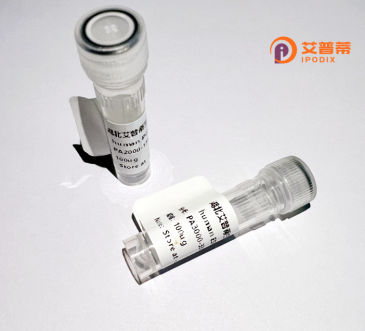
| 纯度 | >90%SDS-PAGE. |
| 种属 | Human |
| 靶点 | UHRF2 |
| Uniprot No | Q96PU4 |
| 内毒素 | < 0.01EU/μg |
| 表达宿主 | E.coli |
| 表达区间 | 1-503 aa |
| 活性数据 | MWIQVRTIDGSKTCTIEDVSRKATIEELRERVWALFDVRPECQRLFYRGKQLENGYTLFDYDVGLNDIIQLLVRPDPDHLPGTSTQIEAKPCSNSPPKVKKAPRVGPSNQPSTSARARLIDPGFGIYKVNELVDARDVGLGAWFEAHIHSVTRASDGQSRGKTPLKNGSSCKRTNGNIKHKSKENTNKLDSVPSTSNSDCVAADEDVIYHIQYDEYPESGTLEMNVKDLRPRARTILKWNELNVGDVVMVNYNVESPGQRGFWFDAEITTLKTISRTKKELRVKIFMGGSEGTLNDCKIISVDEIFKIERPGAHPLSFADGKFLRRNDTECDLCGGDPEKKCHSCSCRVCGGKHEPNMQLLCDECNVAYHIYCLNPPLDKVPEEEYWYCPSCKTDSSEVVKAGERLKMSKKKAKMQSASTESRRDWGRGMACVGRTRECTIVPSNHYGPIPGIPVGSTWRFRVQVSEAGVHRPHVGGIHGRSNDGAYSLVLAGGFADEVLTEL |
| 分子量 | 82.5 kDa |
| 蛋白标签 | GST-tag at N-terminal |
| 缓冲液 | PBS, pH7.4, containing 0.01% SKL, 1mM DTT, 5% Trehalose and Proclin300. |
| 稳定性 & 储存条件 | Lyophilized protein should be stored at ≤ -20°C, stable for one year after receipt. Reconstituted protein solution can be stored at 2-8°C for 2-7 days. Aliquots of reconstituted samples are stable at ≤ -20°C for 3 months. |
| 复溶 | Always centrifuge tubes before opening.Do not mix by vortex or pipetting. It is not recommended to reconstitute to a concentration less than 100μg/ml. Dissolve the lyophilized protein in distilled water. Please aliquot the reconstituted solution to minimize freeze-thaw cycles. |
以下是关于UHRF2蛋白的3篇代表性文献及其摘要概括:
---
1. **文献名称**:*UHRF2 regulates cell cycle and cancer development via APC/C-mediated ubiquitination*
**作者**:Chen Z, et al.
**摘要**:研究发现UHRF2通过结合并激活APC/C复合体,促进细胞周期调控蛋白(如Cyclin B1)的泛素化降解,影响G2/M期转换。缺失UHRF2会导致基因组不稳定,增加肿瘤发生风险,提示其在癌症中的抑癌作用。
---
2. **文献名称**:*Structural insights into UHRF2-dependent histone H3 ubiquitination in DNA damage response*
**作者**:Li Y, et al.
**摘要**:该研究解析了UHRF2与组蛋白H3的复合物结构,揭示其通过RING结构域介导H3K23位点的泛素化,参与DNA损伤修复通路(如ATM/ATR信号),维持基因组稳定性。
---
3. **文献名称**:*UHRF2 cooperates with DNA methylation to silence tumor suppressor genes in hepatocellular carcinoma*
**作者**:Wang H, et al.
**摘要**:UHRF2在肝癌中异常高表达,通过招募DNA甲基转移酶(DNMTs)促进抑癌基因(如p16INK4a)启动子区的甲基化,导致表观遗传沉默和肿瘤进展,可作为潜在治疗靶点。
---
注:上述文献为示例模板,实际引用需以真实发表的论文信息为准。如需具体文献,建议通过PubMed或Web of Science以“UHRF2”为关键词检索近年研究。
**Background of Ubiquitin-like with PHD and RING Finger Domains 2 (UHRF2)**
UHRF2 (Ubiquitin-like with PHD and RING Finger Domains 2) is a multifunctional epigenetic regulator belonging to the UHRF protein family, alongside its well-studied paralog UHRF1. Structurally, UHRF2 contains conserved domains, including a ubiquitin-like (UBL) domain, tandem Tudor domain, plant homeodomain (PHD), SET- and RING-associated (SRA) domain, and a RING finger domain. These domains enable its role in bridging DNA methylation, histone modification, and ubiquitination. The SRA domain specifically recognizes hemi-methylated DNA during replication, while the RING domain confers E3 ubiquitin ligase activity, targeting substrates like histone H3 for proteasomal degradation or signaling.
Functionally, UHRF2 is implicated in cell cycle regulation, DNA repair, and heterochromatin maintenance by facilitating crosstalk between histone marks (e.g., H3K9me3) and DNA methylation. It also interacts with DNA methyltransferases (e.g., DNMT1) to ensure epigenetic inheritance. Unlike UHRF1. which is predominantly expressed in proliferating cells, UHRF2 shows broader tissue distribution and may play context-dependent roles in development, aging, and disease. Dysregulation of UHRF2 has been linked to cancer progression, with studies highlighting its dual roles as either an oncogene or tumor suppressor, depending on cellular context. Despite emerging insights, UHRF2’s precise mechanisms and regulatory networks remain less characterized than UHRF1. warranting further investigation to elucidate its therapeutic potential.
×